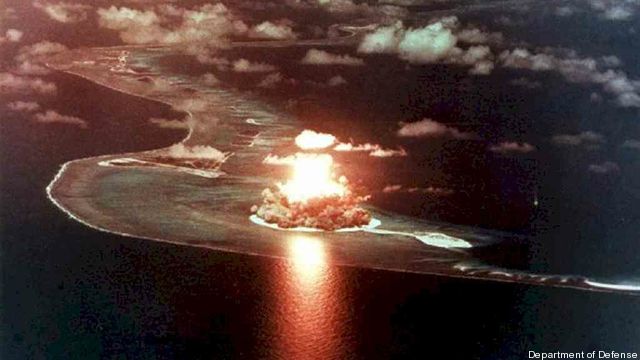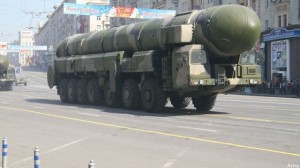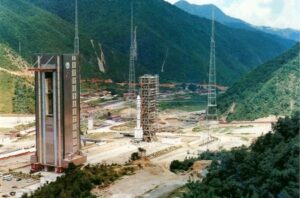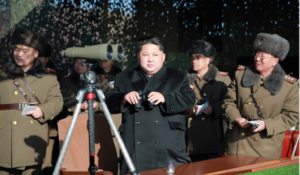‘Let It Be An Arms Race’: Our Nuclear Adversaries Have Already Started
Posted on

President-elect Donald Trump took to Twitter on December 22 to say “The United States must greatly strengthen and expand its nuclear capability until such time as the world comes to its senses regarding nukes.” He later called MSNBC TV host Mika Brzezinski and reportedly said, “Let it be an arms race. We will outmatch them at every pass and outlast them all.”
The United States must greatly strengthen and expand its nuclear capability until such time as the world comes to its senses regarding nukes
— Donald J. Trump (@realDonaldTrump) December 22, 2016
While a return to 20,000-plus operationally deployed strategic nuclear weapons is not desirable, over the past decade America’s adversaries have replaced aging delivery vehicles and warheads, giving Russia, China, and North Korea capabilities they did not have a decade ago. The arms race has started without us.
 Russia
Russia
The Strategic Rocket Forces are fielding a number of new intercontinental ballistic missiles as Russia seeks to replace Cold War weapons. Russia is currently replacing its remaining SS-18 and SS-19 Mod 3 intercontinental ballistic missiles (ICBMs) — which were designed and deployed about the same time as American Minuteman III ICBMs — with SS-27 Topol-M and SS-29 Yars-M ICBMs designed in the 1990s and 2000s. These new ICBMs are silo-based and road- or rail-mobile. Locating and targeting mobile ICBMs is particularly difficult for American targeteers. By 2020, the Russians will field the RS-28 Sarmat, which is often called the “country killer” because it can hold 15 thermonuclear reentry vehicles and is equipped with defensive countermeasures to defeat ballistic missile defenses.
The Russians are also fielding a new class of ballistic missile submarine as a replacement for its fleet of Cold War-era Delta IV submarines. The new Borei class is the quietest Russian submarine produced and can carry up to 16 of the new SS-NX-30 Bulava submarine-launched ballistic missiles (SLBM). With the first Borei-class submarine having entered service in 2009, a total of eight are expected by 2020.
Russia is also modernizing its fleet of Tu-95 Bear-H and Tu-160 Blackjack bombers while it designs and fields a new stealth bomber. The Russians are fielding a new nuclear air-launched cruise missile (ALCM), the Kh-102. The Kh-102 can be launched from bombers while still in Russian airspace and reach the continental United States; radar may not even see these weapons before they enter American airspace.
Russia is also making significant advances in warhead design, which is important as both the United States and Russia are growing increasingly concerned that the other side could destroy incoming warheads through defensive measures. Ensuring warheads detonate, and at the desired yield, when and where they are supposed to do so has been a focus of Russian designers in recent years. With open source information limited, it still appears Russia is making strides in these areas.
 China
China
China’s nuclear deterrent is primarily found in its ballistic missiles. The DF-5 (CSS-4) is a liquid-fueled rocked first deployed in the mid-1980s. This ICBM was designed to strike the United States with a single large-yield warhead because of its limited accuracy. As part of its modernization effort, the DF-5 is being replaced by the DF-41, a solid-fueled ICBM, which has a considerably improved accuracy and response time.
China also fields the DF-31 (CSS-9), a solid-fueled ICBM first deployed in 2006. A recent upgraded to a DF-31A variant gives China the ability to reach the United States with this ICBM’s three warheads. An additional variant is the DF-31B—a road mobile weapon.
The Chinese are also building toward their own nuclear triad by establishing a continuous at-sea deterrent with the Jin-class ballistic missile submarine, first commissioned in 2010 with a total of five expected. Described in open sources as noisy enough to be detected and tracked by the US Navy, it is an inferior submarine, but still a step forward. The Jin will carry up to twelve JL-2 (CSS-NX-4) ballistic missiles, which have a range of approximately 5,000 miles.
China also fielded the H-6K bomber in 2009—a modernized variant of the Soviet-era H-6 bomber—which can carry the CJ-10K cruise missile. Although it is believed that the CJ-10K is conventional only, China could field a nuclear variant. With China seeking regional dominance in Asia, the H6-K’s 2,200 mile range provides ample distance to hold targets in the region at risk.
 North Korea
North Korea
While North Korea has demonstrated the ability to produce a nuclear device and has an active ballistic missile program, it is not clear that it can deliver its nuclear warheads atop a KN-08 road mobile ICBM. Currently, there is no open source evidence to suggest that North Korea has attempted to mate a nuclear warhead with any of its ballistic missiles. However, it is unlikely that North Korean scientists and engineers will fail to overcome existing challenges given Kim Jung-Un’s focus on nuclear weapons.
In short, our adversaries are improving their own nuclear capabilities. It is time we do the same.
Dr. Adam B. Lowther is the Director of the School of Advanced Nuclear Deterrence Studies (SANDS) at Kirtland, AFB. His latest book is Defending the Arsenal: Why America’s Nuclear Modernization Still Matters. The views expressed in this article are Dr. Lowther’s alone and do not represent the official position of SANDS or the Air Force at large.
Subscribe to our newsletter
Promotions, new products and sales. Directly to your inbox.
